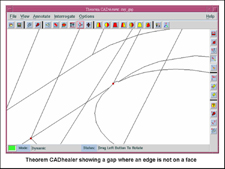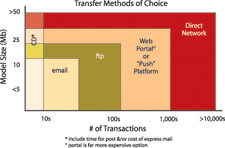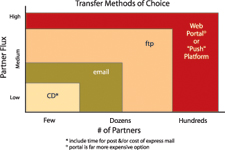By David Prawel
Engineers the world over are well aware of the challenges of sharing CAD datawith colleagues and business partners. Data exchange problems arise on a dailybasis in design, analysis, simulation, manufacturing, and countless other applications.Competitive pressures drive innovation and demand quality, and creating increasinglycomplex products has led most companies to depend on global business partnersfor component parts. We all know success depends on how well business partnerscollaborate and react to changes in design and process, regardless of their geographiclocation. Thus the fast, efficient sharing of product data is critical.
Studies suggest that problems encountered in sharing engineering data for theautomobile industry could cost $10 billion per year, a most formidable impedimentto accelerating a product’s time-to-market.
Pinpointing Errors in Data Translation
Poor data translation is the most publicized and costly problem in CAD data exchange.Translation problems result from many issues: geometry, topology, model precision,features, and countless more. Errors that often mean you have to recreate thedata or the complete model, for example, are edges and faces that have small gapsbetween them, sliver faces that have very thin aspect ratios and are generallyvery hard to detect, duplicate vertices and edges, and faces with inverse orientation.Other causes of error include poorly trained CAD designers, general sloppiness,and mathematical inconsistencies inherent in CAD systems that use different modelingtechniques and algorithms.

Right: Theorem Solutions’s CADhealer
showing a gap where an edge is not on a face.
Translation of features and history is especially problematic. Feature representationsare particularly unique and proprietary to each CAD system. The neutral standard,IGES (initial graphics exchange specification), doesn’t translate features, andthe STEP exchange standard still has a lot of room for improvement in this area.The most promising approach seems to be decomposing and transferring the featureand history tree and recreating the model in the destination CAD system. Vendorssuch as Proficiency with its Collaboration Gateway are making excellent progressusing this approach.
Spatial’s Interoperability Solution, Theorem Solutions’s CADhealer, Transcendata’sCadfix, and other vendors’ software have made significant advances in “healing"technology, showing promise for automating the repair of many translation problems.These tools work well in 75 to 80 percent of cases, but have not reached perfectionnor become fully automated and might never be.
Further magnifying the cost of poor-quality data translation is the fact thatmany errors go undetected until late in the design process, when they create moreexpensive problems. For example, an error in a CAD file that might not appearto CAD users could appear during FEA (finite element analysis), when engineersare creating physical prototypes, or even further downstream as they develop tooling.Different applications put model data to different uses, each potentially exposingdifferent effects of poor data quality, and all causing model rework and projectdelay. It is not uncommon to find engineers in rapid prototyping, FEA, or CNCprogramming spending as much as 50 percent of their time fixing CAD data filesthat exhibit quality exchange problems of some sort.
Multiple Systems Not an Answer
The largest manufacturers are accustomed to dictating to suppliers which CADsystems they use and have tried for many years to enforce their requirements.Though this method appears to be the simplest way to minimize interoperabilityproblems, unfortunately it’s not that easy. In fact, it might be the more expensivemethod when all direct and indirect costs are considered. Costs to the suppliermust be absorbed either by way of quality, timing, or price.
Right: These are preferred methods for transferring
files as they relate to model size and number of files.
Suppliers who are forced to support each CAD system need trained staff to usethem and those costs transfer back to the customer as program overhead. Otherfactors contribute to the apparent move away from this approach. For example,because no single CAD system is the best for all programs, suppliers must makesacrifices when forced to use a particular set of tools. Such sacrifices translateinto indirect, intangible costs, such as lost opportunity for innovation or longertime to market. Having realized insufficient cost advantages from forcing suppliersto use their CAD systems, many global manufacturers have ceased this practice,and now make these decisions on a program or case-by-case basis.
Specific Program Advantages
Among the standard neutral file formats, such as STEP and IGES, IGES is the mostpopular. Satisfactory results can be achieved with IGES file transfers, even with3D data but, as always, success depends on the application and the data. One ofthe disadvantages of neutral format translation is that it requires an extra translationstep to and from the neutral format, thereby increasing the risk of error. IGESalso provides limited support for different data types and applications. Interoperabilityinvolves many departments, such as engineering, purchasing, and marketing. Additionally,product data includes a very wide range of data types, not just CAD geometry.All of this limits the effective use of IGES except in relatively simple cases.
On the other hand, STEP was designed to support a very wide variety of functionaland business requirements. Its broad scope and associated complexity, combinedwith the relatively high cost of STEP translators, however, continue to impedeits adoption.

Right: This table is a description of the preferred methods for transferringfiles as they relate to changes in partner flux (turnove) and the number of partnerswho would need access to the files.
Commercial translators are available for a wide variety of CAD formats. Thesecan be purchased from the vendors of the CAD systems or from numerous independentsuppliers. In general, the independents seem to be more successful and less expensivethan translators from CAD vendors, but both work reasonably well and can yieldacceptable ROI, depending again on the data and the application. As usual, thereis no substitute for good testing using a wide range of data typical of your business,and “round trip” testing—to and from another format to produce the same results—asverified by quality checking tools like I/Check from INCAT is invaluable.
Though the most costly and visible product data exchange problems derive frompoor product data translation between different CAD systems and formats, significantcosts can also be associated with a lack of data transfer tools that streamlinedata transfer processes. The lack of management understanding and acknowledgementof the nature and impact of these problems is likewise harmful.
Data Transfer Issues
Significant hidden costs to productivity also result from time wasted sendingand receiving product data between business partners. Huge amounts of data aresent and received daily in manufacturing. In a typical year large manufacturerstransfer 300,000 to 400,000 files within their company and among their suppliers.These estimates are significantly magnified when non-CAD product data is included.
There are many methods of transferring product data, and each has advantagesand disadvantages. These depend on many factors: the CAD systems used at eachend of a transaction, the number of transactions, the size of the typical file,and the number of suppliers with whom data is exchanged. The best method willresult from a careful evaluation of these issues, and calls for acknowledgementand support from all levels of management.
E-mail is the most common method of data transfer between parties. Although inefficient,error prone, and insecure, it works. As transactions and file sizes increase,however, e-mail data transfer slows down and becomes increasingly ineffective.
The Hidden Expense of CAD Interoperability
One significant and virtually unaddressed source of data exchange cost is thelack of communication infrastructure to support effective data transfers. A hugeamount of engineering time is spent performing manual tasks associated with sendingand receiving data, confirming receipt, checking contact and version information,resending lost data, and so forth, all tasks that could easily be automated.
Currently, it is up to the engineers to maintain all the information about businesspartners. They are supposed to know who should get files at each particular partnercompany; keep track of e-mail addresses, contact information, required formats,and versions; log and archive transmission events; track notification receipts;record authorizations; and more. They generally don’t have a secure or effectivemethod. Consider the cost of resending even a small percentage of 250,000 filessimply because data was sent to the wrong address or in the wrong format.
Respected solutions are available that address these tasks while reducing thecosts and risks of e-mail-based data exchange. Products like DDX from ProCAEsshelp engineers push data to partners by providing a secure data transfer infrastructurethat automates repetitive tasks and maintains all the necessary data transferinformation. Another solution, called AutoWeb, provides a data transfer portalfor automotive suppliers.
Interoperability Begins with Involved Management
Interoperability is typically addressed from within the engineering or IT departments,as might be expected. Most often, a dedicated and informed engineer who understandsthe importance of efficient product data exchange will personally take responsibilityfor it. These forward-thinking and dedicated professionals generally receive verylittle support or recognition from their colleagues or from management.
Management sometimes understands the cost of poor data exchange to the business,but very few attempt to measure it. Though managers understand the significantdirect costs and hidden losses in opportunity associated with poor product dataexchange, they often ignore these costs, which are then passed on to the programor project.
Instead, management should consider implementing a cross-functional interoperabilityteam. And since good methodology can prove highly valuable, this team should beempowered to develop and implement policies and processes for interoperability.A simple private message board used by experienced engineers to share best practicesand make suggestions can also help such a team. These have helped reduce dataexchange costs, since success rates appear to improve dramatically between engineersexperienced in its pitfalls.
|
Product and Company Information
AutoWeb File Exchange (AFX) Autoweb Rochester Hills, MI Interoperability Solution Spatial Corp. (division of Dassault) Westminster, CO |
There is no substitute for investing in data exchange training for CAD users.Training and consulting are more than worth the cost. Research suggests that traineddesigners and engineers can reduce interoperability problems by 15 to 25 percent.
A dedicated data exchange person is a wasted engineering resource. The processshould be automated so engineers can focus on engineering. Invest in good translationand transfer tools and develop close relationships with software vendors and serviceproviders. These companies have significant experience and skills and can provevery cost effective when problems arise.
Competitiveness in global manufacturing has amplified both the impact of poorCAD interoperability and the urgency for solutions. As reliance on outsourcingand offshore engineering increases, data exchange problems result in huge directand hidden costs that secretly undermine productivity and time to market. Solutionsshould be implemented as core business processes supported heartily by management.Our survival could depend on it.
David Prawel is president and principal consultant at LongView Advisors Inc. (Loveland, CO), a manufacturing and software consulting company specializingin product data exchange and commercialization. He has held senior and executivemanagement positions with several manufacturing software companies over the last25 years. You can contact David about this article via e-mail clicking here. Please reference “CAD Data Exchange” in your message.









